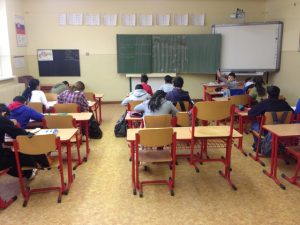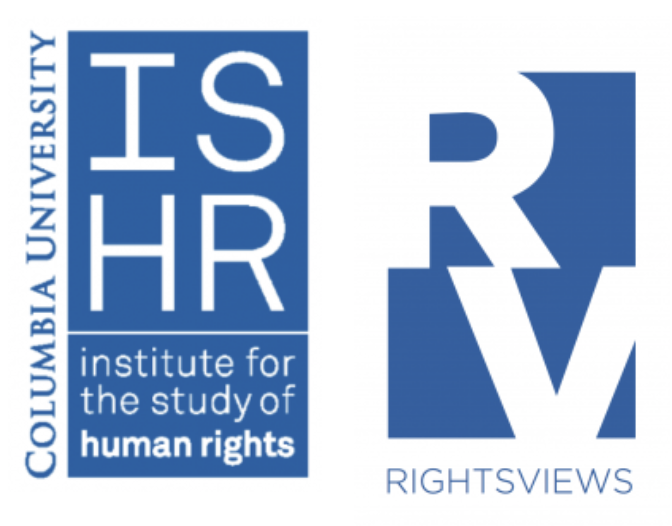By Claudia Kania, guest blogger from Reavis high school
The United Nations Committee on the Elimination of All Forms of Racial Discrimination (CERD) released a statement in 2000 that acknowledged “the place of the Roma communities among those most disadvantaged and most subject to discrimination in the contemporary world.” Such socially and institutionally-accepted xenophobia is perhaps most clearly epitomized by the European school system. Although academic institutions are often portrayed as “the great equalizers,” a system founded on the principles of ignorance and prejudice frequently separates Roma, one of the largest minority groups in Europe, from reaping the benefits of education.
The right to education is universally established as a fundamental guiding principle within international human rights discourse. It is recognized as a human right by Article 26 of the Universal Declaration of Human Rights, as well as Articles 28, 29, and 40 of the Convention on the Rights of the Child. To further contextualize the premise of academic equity, UNESCO put forth the 1960 Convention against Discrimination in Education, an international legislative framework adopted to promote “the ideal of equality of educational opportunity without regard to race, sex or any distinctions, economic or social.” This convention recognizes education as not only a right in and of itself, but also as an intrinsic vehicle in realizing other rights. It is an instrument vital in securing a life free of financial hardship, disenfranchisement and social exclusion.
A report released in 2016 detailed the true scope of the expulsion of Roma communities to the fringes of European society. For example, while approximately 17 percent of EU citizens are at risk of poverty, that number is more than four times higher for Romani individuals. In the month prior to the study, only about 30 percent of Romani households received paid work. The Office for National Statistics further revealed that out of 60,000 individuals who identified as Roma, 60 percent had no formal schooling. Moreover, Roma individuals are often the victims of hate crimes and police brutality.

Segregation remains one of the primary obstacles standing between Roma pupils and equal education opportunities. Although prejudice is sometimes blatantly propagated by biased media and political campaigns, such instances present a gateway to other less conspicuous modes of discrimination. For instance, lower expectations for Roma students subsequently led to higher dropout rates within their communities, which substantially decreases the prospects of secondary and tertiary education for Roma individuals. This, in turn, translates to higher unemployment rates and hinders the participation of Roma in the democratic process. Thus, the cycle continues.
A 2015 report by Amnesty International illustrates discriminatory placement of Romani students in remote classes separating students from their non-Roma peers. A UNICEF report, specifically noting a 2002 case in Hungary, states that, in general, all-Roma classrooms typically lack fundamental resources otherwise available to students not of the Roma ethnicity, including experienced teachers and up-to-date curricula. More recently, the European Commission specifically targeted discrimination within Hungarian schools. Although EU member states are expected to abide by equal education frameworks, legal directives such as the Racial Equality Directive and the EU Charter of Fundamental Rights oftentimes have little impact on institutionalized forms of ethnic discrimination.
In 2012, The Slovakian Regional Court condemned the segregation of Roma in its schools. Although the ruling sent a message to the Slovakian Ministry of Education regarding the country’s international obligations to provide impartial access to education, it did little to prevent ethnic-based segregation. Not only do schools continue to run all-Roma classes, but Slovakian Roma pupils are faced with the prospect of being sent to “container schools,” schools made from material resembling shipping containers, and isolated from the rest of Slovak society. When the guardians of Roma students attempt to enroll their children in non-container schools, their pleas are refused by school board officials who argue that their schools do not have the capacity to accommodate Roma pupils. The “convenient” construction of substandard learning institutions within close geographic proximity to Roma settlements is nothing other than an arm of ethnic discrimination and social exclusion, as noted by Amnesty International.
The European Roma community also faces another kind of widespread segregation: Roma pupils are frequently placed in learning disability schools, regardless of scholastic comprehension. A 2013 ruling by the European Court of Human Rights remarked that Hungary’s systematic misdiagnosis of learning disabilities violated the European Convention on Human Rights. In addition, a 2012 report by the Roma Education Fund highlights the prejudicial nature of such entrance level examinations, which focus specifically on cultural and linguistic biases.

Cases of outright denial to enroll Romani children to academic institutions continue to remain prominent. The mayors of several French municipalities, for example, refused to enroll Roma children in public schools on the basis of their lack of certification. Certification, however, is not easily achieved by Roma parents, as informal settlements are almost never recognized by government officials. As identity documents remain largely inaccessible to Roma individuals, most families remain stateless. Thus, admission, in most cases, is granted only after the intervention of the French Ombudsmen. A recent article by the New York Times highlights the bureaucratic obstacles Roma students face when attempting to gain access to French schools. The country has made headlines due to the forced evacuation of hundreds of Roma families.
Former Columbia Law professor Jack Greenberg linked the Roma battle for equal education to the American Civil Rights Movement. Both groups have experienced the harrowing realities of slavery, societal disenfranchisement, and discrimination, propagated in part by stereotyping in a biased media. Schools today segregate non-Roma students from their Roma peers, providing the latter with substandard educational resources. The case of Horváth and Kiss v. Hungary bears a striking resemblance to Brown v. Board of Education of Topeka. Although both rely on the concept of strategic litigation, the successful implementation of anti-discriminatory education policy is currently a far reach for contemporary Europe. It will require not only the willingness of policymakers, but also the active mobilization of Roma civil society.
Locally, individual schools should engage in active redistricting in order to achieve ethnic diversity within academic institutions, as well as incorporate Romani culture into standing curricula to promote diversity and ethnic tolerance. It is well within the means of any school within the EU to guarantee an environment based on social inclusion and academic equity. Likewise, it is crucial that international bodies, such as the European Commission and European Union, apply political pressure on national governments to uphold international and national legislative standards of equality. The implementation of such standards and their effects on academic institutions should be monitored by national bodies, benefiting from the interests of both grassroot NGOs and international donors.
Claudia Kania is a contributing researcher for the University of Cambridge Centre for Governance and Human Rights research project, “ICTs and Human Rights,” as well as featured writer for the Oxford Human Rights Hub. Her research interests include minority rights, women’s rights, and education policy.
